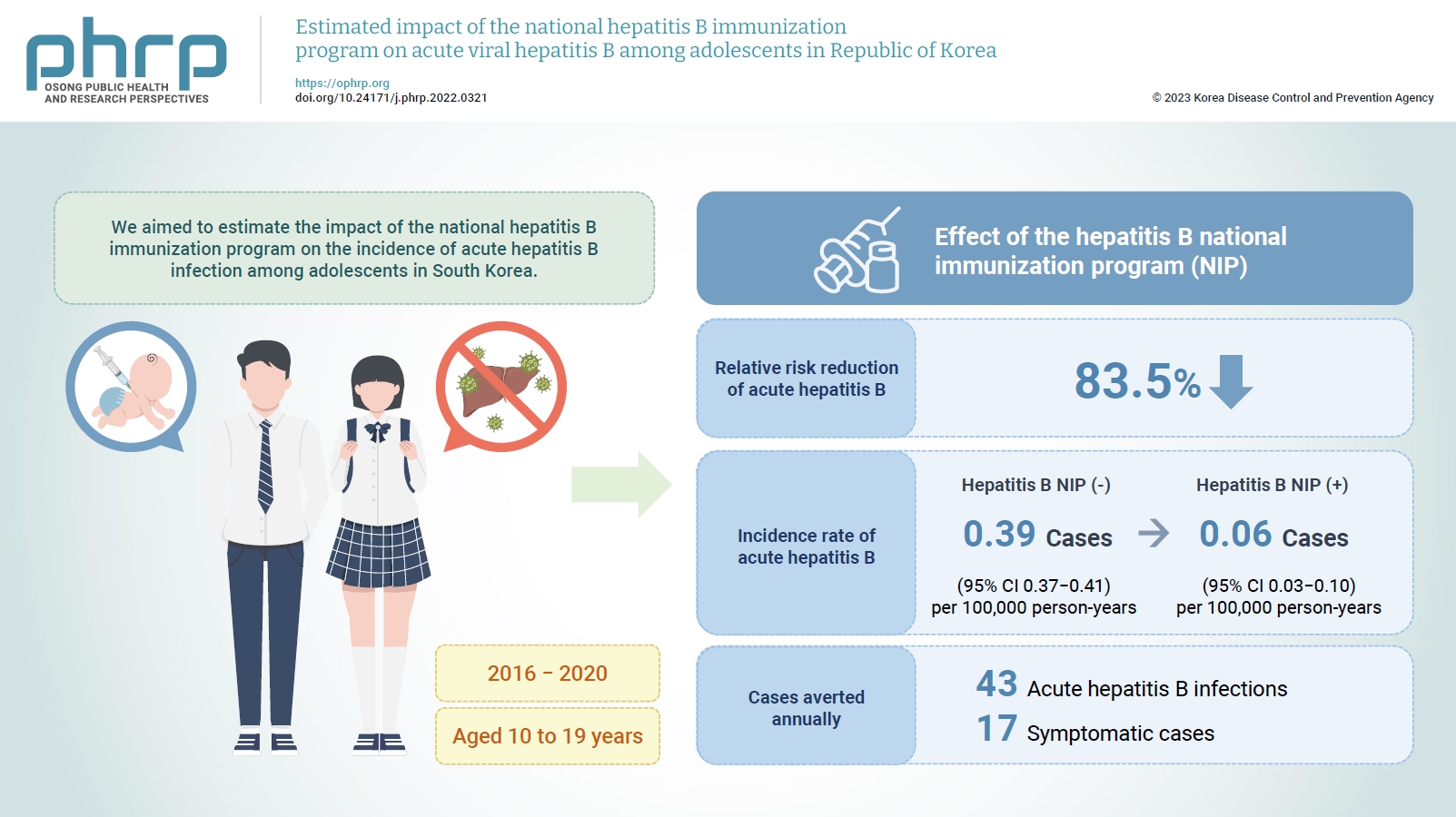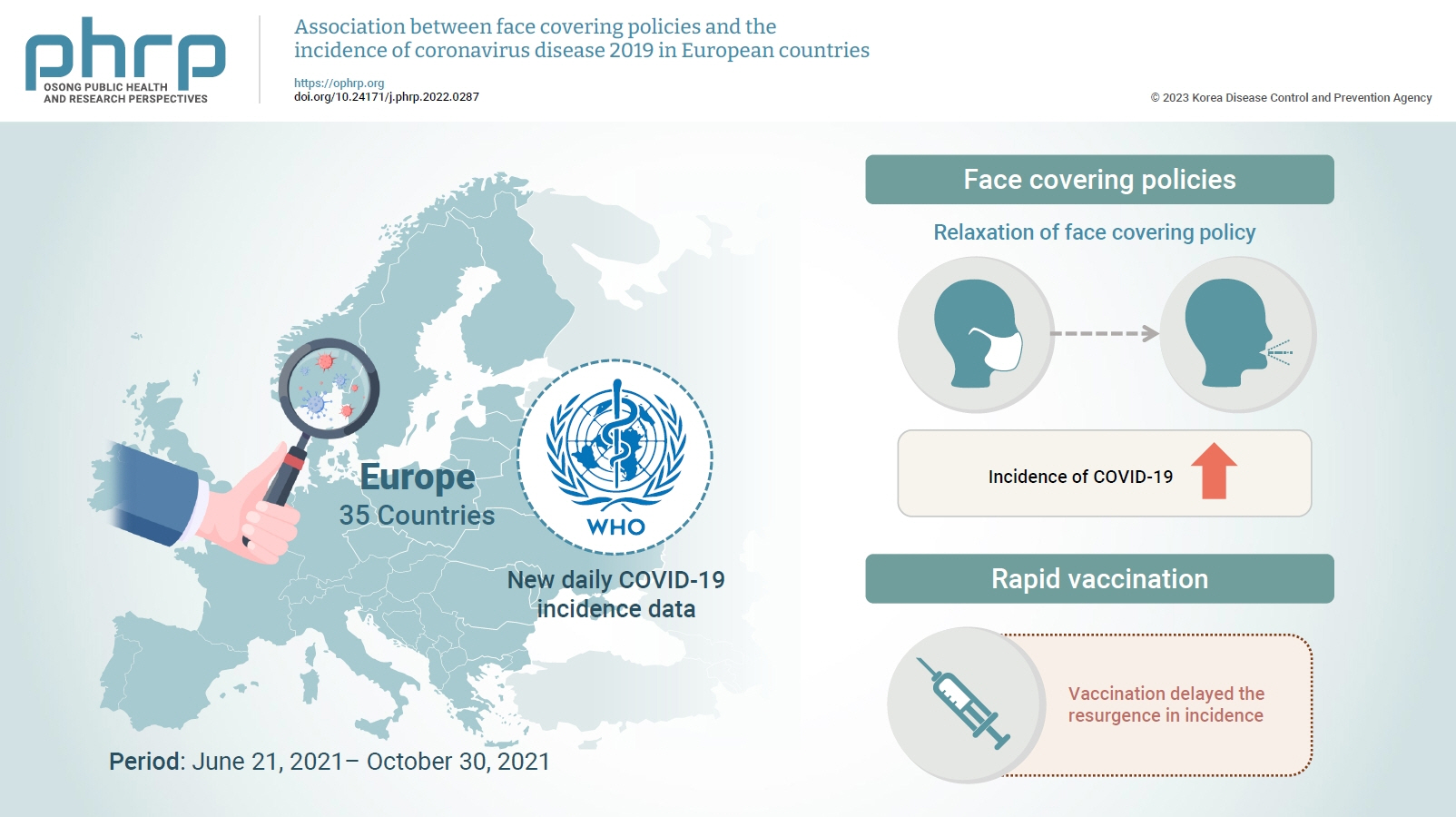Search
- Page Path
- HOME > Search
- Factors associated with the timely diagnosis of malaria and the utilization of types of healthcare facilities: a retrospective study in the Republic of Korea
- HyunJung Kim, Sangwoo Tak, So-dam Lee, Seongwoo Park, Kyungwon Hwang
- Received November 20, 2023 Accepted January 18, 2024 Published online April 16, 2024
- DOI: https://doi.org/10.24171/j.phrp.2023.0349 [Epub ahead of print]
- 262 View
- 8 Download
-
 Abstract
Abstract
 PDF
PDF - Objectives
This study aimed to analyze trends in the timely diagnosis of malaria cases over the past 10 years in relation to the utilization of different types of healthcare facilities.
Methods
The study included 3,697 confirmed and suspected cases of malaria reported between January 1, 2013, and December 31, 2022, in the national integrative disease and healthcare management system. Some cases lacking a case report or with information missing from the case report were excluded from the analysis. A generalized linear model with a Poisson distribution was constructed to estimate rate ratios and 95% confidence intervals adjusted for other variables, such as distance.
Results
When cases involving diagnosis >5 days after symptom onset in confirmed patients (5DD) were examined according to the type of healthcare facility, the rate ratio of 5DD cases was found to be higher for public health facilities than for tertiary hospitals. Specifically, the rate ratio was higher when the diagnosis was established at a tertiary hospital, even after a participant had visited primary or secondary hospitals. In an analysis adjusted for the distance to each participant’s healthcare facility, the results did not differ substantially from the results of the crude analysis.
Conclusion
It is imperative to improve the diagnostic capabilities of public facilities and raise awareness of malaria at primary healthcare facilities for effective prevention and control.
- Response to the comment of Perone by the corresponding author Kim
- Yongmoon Kim, Bryan Inho Kim, Sangwoo Tak
- Osong Public Health Res Perspect. 2023;14(2):147-147. Published online March 24, 2023
- DOI: https://doi.org/10.24171/j.phrp.2023.0072R
- 740 View
- 31 Download
- Estimated impact of the national hepatitis B immunization program on acute viral hepatitis B among adolescents in Republic of Korea
- Chungman Chae, Sangwoo Tak
- Osong Public Health Res Perspect. 2023;14(2):138-145. Published online March 24, 2023
- DOI: https://doi.org/10.24171/j.phrp.2022.0321
- 1,534 View
- 62 Download
-
 Graphical Abstract
Graphical Abstract
 Abstract
Abstract
 PDF
PDF 
- Objectives
We aimed to estimate the impact of the national hepatitis B immunization program on the incidence of acute hepatitis B infection among adolescents in South Korea.
Methods
We estimated the counterfactual incidence rate of reported acute hepatitis B among adolescents from 2016 to 2020 compared to the assumption that the national hepatitis B immunization program for children had not been implemented since 1995. The impact of the national hepatitis B immunization program for adolescents was measured by estimating the absolute risk reduction and averted acute hepatitis B infections among adolescents from 2016 to 2020 attributed to the national immunization program.
Results
The relative risk reduction of acute hepatitis B among adolescents was estimated to be 83.5% after implementing the national hepatitis B immunization program. The incidence rate of reported acute hepatitis B infections among adolescents decreased from 0.39 to 0.06 per 100,000 person-years, and 43 acute hepatitis B infections, including 17 symptomatic cases, were averted annually from 2016 to 2020 by the national hepatitis B immunization program.
Conclusion
The national hepatitis B immunization program for children was effective in preventing acute hepatitis B infection among adolescents in South Korea.
- Association between face covering policies and the incidence of coronavirus disease 2019 in European countries
- Sookhyun Kim, Jiyoung Oh, Sangwoo Tak
- Osong Public Health Res Perspect. 2023;14(1):31-39. Published online February 1, 2023
- DOI: https://doi.org/10.24171/j.phrp.2022.0287
- 2,020 View
- 72 Download
-
 Graphical Abstract
Graphical Abstract
 Abstract
Abstract
 PDF
PDF 
- Objectives
This study was conducted to determine the impact of the strengthening or relaxation of face covering mandates on the subsequent national case incidence of coronavirus disease 2019 (COVID-19) in Europe as the full vaccination rate was increasing.
Methods
European countries in which case incidence increased for 3 consecutive weeks were monitored and analyzed using COVID-19 incidence data shared by the World Health Organization (WHO). The epidemic trend of COVID-19 in Europe was compared with that of countries elsewhere in the world based on WHO weekly epidemiological reports from June 20 to October 30, 2021. In addition, this study provided insight into the impact of government mask mandates on COVID-19 incidence in Europe by measuring the index scores of those facial covering policies before and after mandate relaxation or strengthening. The effects of the vaccination rate and the speed of vaccination on COVID-19 incidence were also analyzed.
Results
The incidence of COVID-19 after the relaxation of face covering mandates was significantly higher than before relaxation. However, no significant difference was observed in vaccination rate between countries with increased and decreased incidence. Instead, rapid vaccination delayed the resurgence in incidence.
Conclusion
The findings suggest that face covering policies in conjunction with rapid vaccination efforts are essential to help mitigate the spread of COVID-19.
- Time-series comparison of COVID-19 case fatality rates across 21 countries with adjustment for multiple covariates
- Yongmoon Kim, Bryan Inho Kim, Sangwoo Tak
- Osong Public Health Res Perspect. 2022;13(6):424-434. Published online November 28, 2022
- DOI: https://doi.org/10.24171/j.phrp.2022.0212
- 2,750 View
- 112 Download
- 1 Web of Science
- 1 Crossref
-
 Graphical Abstract
Graphical Abstract
 Abstract
Abstract
 PDF
PDF 
- Objectives
Although it is widely used as a measure for mortality, the case fatality rate (CFR) ofcoronavirus disease 2019 (COVID-19) can vary over time and fluctuate for many reasons otherthan viral characteristics. To compare the CFRs of different countries in equal measure, weestimated comparable CFRs after adjusting for multiple covariates and examined the mainfactors that contributed to variability in the CFRs among 21 countries.Methods: For statistical analysis, time-series cross-sectional data were collected from OurWorld in Data, CoVariants.org, and GISAID. Biweekly CFRs of COVID-19 were estimated bypooled generalized linear squares regression models for the panel data. Covariates includedthe predominant virus variant, reproduction rate, vaccination, national economic status,hospital beds, diabetes prevalence, and population share of individuals older than age 65. Intotal, 21 countries were eligible for analysis.Results: Adjustment for covariates reduced variation in the CFRs of COVID-19 across countriesand over time. Regression results showed that the dominant spread of the Omicron variant,reproduction rate, and vaccination were associated with lower country-level CFRs, whereasage, the extreme poverty rate, and diabetes prevalence were associated with higher countrylevel CFRs.Conclusion: A direct comparison of crude CFRs among countries may be fallacious, especiallyin a cross-sectional analysis. Our study presents an adjusted comparison of CFRs over timefor a more proper comparison. In addition, our findings suggest that comparing CFRs amongdifferent countries without considering their context, such as the epidemic phase, medicalcapacity, surveillance strategy, and socio-demographic traits, should be avoided. -
Citations
Citations to this article as recorded by- Comments on the article "Time-series comparison of COVID-19 case fatality rates across 21 countries with adjustment for multiple covariates"
Gaetano Perone
Osong Public Health and Research Perspectives.2023; 14(2): 146. CrossRef
- Comments on the article "Time-series comparison of COVID-19 case fatality rates across 21 countries with adjustment for multiple covariates"
- Changes in the pattern and disease burden of acute respiratory viral infections before and during the COVID-19 pandemic
- Chungmin Park, Donghan Lee, Bryan Inho Kim, Sujin Park, Gyehee Lee, Sangwoo Tak
- Osong Public Health Res Perspect. 2022;13(3):203-211. Published online June 30, 2022
- DOI: https://doi.org/10.24171/j.phrp.2022.0144
- 4,411 View
- 168 Download
- 1 Web of Science
- 1 Crossref
-
 Abstract
Abstract
 PDF
PDF - Objectives
We conducted a comparative analysis of the differences in the incidence of 8 acute respiratory viruses and the changes in their patterns before and during the coronavirus disease 2019 (COVID-19) pandemic. Methods: Three sentinel surveillance systems of the Korea Disease Control and Prevention Agency and data from the Health Insurance Review and Assessment Service were analyzed. The average numbers of reported cases and the related hospital admissions and outpatient data were compared between April 2018–2019 and 2020–2021. Changes in the disease burden and medical expenditures between these 2 time periods were evaluated. Results: During the COVID-19 pandemic, the number of reported cases of all acute respiratory viral infections, except for human bocavirus, decreased significantly. Data from the Health Insurance Review and Assessment Service also showed decreases in the actual amount of medical service usage and a marked reduction in medical expenditures. Conclusion: Non-pharmacological interventions in response to COVID-19 showed preventive effects on the transmission of other respiratory viruses, as well as COVID-19. Although COVID-19 had a tremendous impact on society as a whole, with high social costs, there were also positive effects, such as a reduction in the incidence of acute respiratory viral infections. -
Citations
Citations to this article as recorded by- Machine learning forecasts for seasonal epidemic peaks: Lessons learnt from an atypical respiratory syncytial virus season
Roger A. Morbey, Daniel Todkill, Conall Watson, Alex J. Elliot, André Ricardo Ribas Freitas
PLOS ONE.2023; 18(9): e0291932. CrossRef
- Machine learning forecasts for seasonal epidemic peaks: Lessons learnt from an atypical respiratory syncytial virus season
- Enhancing ‘Whole-of-Government’ Response to Biological Events in Korea: Able Response 2014
- Sangwoo Tak, Anton Jareb, Suon Choi, Marvin Sikes, Yeon Hwa Choi, Hyeong-wook Boo
- Osong Public Health Res Perspect. 2018;9(1):32-35. Published online December 31, 2017
- DOI: https://doi.org/10.24171/j.phrp.2018.9.1.06
- 5,148 View
- 41 Download
- 3 Crossref
-
 Abstract
Abstract
 PDF
PDF Since 2011, the Republic of Korea (ROK) and United States (U.S.) have been collaborating to conduct inter- and intra-governmental exercises to jointly respond to biological events in Korea. These exercises highlight U.S. interest in increasing its global biosurveillance capability and the ROK’s interest in improving cooperation among ministries to respond to crises. With Able Response (AR) exercises, the ROK and U.S. have improved coordination among US and ROK government and defense agencies responding to potential bio-threats and identified additional areas on which to apply refinements in policies and practices. In 2014, the AR exercise employed a Biosurveillance Portal (BSP) to facilitate more effective communication among participating agencies and countries including Australia. In the present paper, we seek to provide a comprehensive assessment of the AR 2014 (AR14) exercise and make recommendations for future improvements. Incorporating a more realistic response in future scenarios by integrating a tactical response episode in the exercise is recommended.
-
Citations
Citations to this article as recorded by- Artificial intelligence in public health: the potential of epidemic early warning systems
Chandini Raina MacIntyre, Xin Chen, Mohana Kunasekaran, Ashley Quigley, Samsung Lim, Haley Stone, Hye-young Paik, Lina Yao, David Heslop, Wenzhao Wei, Ines Sarmiento, Deepti Gurdasani
Journal of International Medical Research.2023; 51(3): 030006052311593. CrossRef - Whole of government and whole of society approaches: call for further research to improve population health and health equity
Flaminia Ortenzi, Robert Marten, Nicole B Valentine, Aku Kwamie, Kumanan Rasanathan
BMJ Global Health.2022; 7(7): e009972. CrossRef - Biodefence research two decades on: worth the investment?
Carrie M Long, Andrea Marzi
The Lancet Infectious Diseases.2021; 21(8): e222. CrossRef
- Artificial intelligence in public health: the potential of epidemic early warning systems



 First
First Prev
Prev


